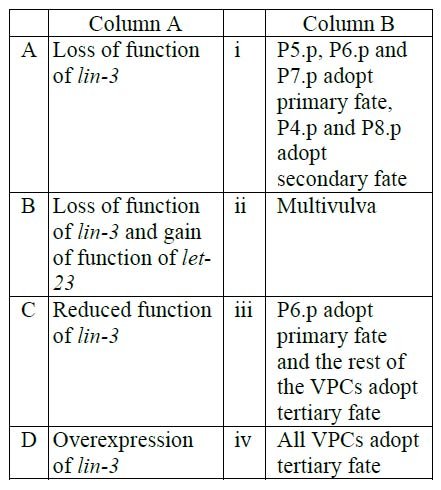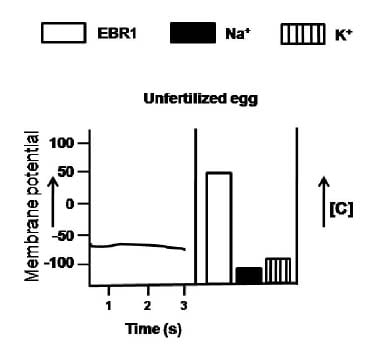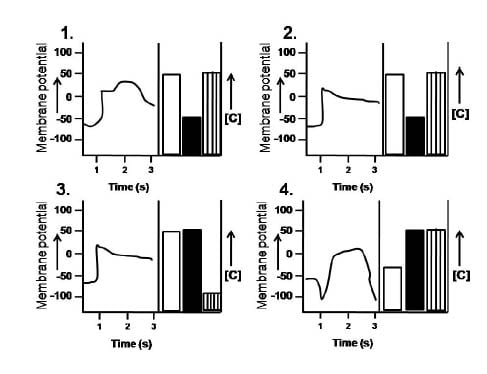Dear Students,
Welcome to Developmental Biology MCQ – 01 (Developmental Biology CSIR NET). This MCQ set consists of Advanced (PG Level) Developmental Biology / Embryology Multiple Choice Questions taken from the previous year question papers of CSIR NET Life Sciences Examination. These questions can be used for the preparation of Competitive examinations in Biology / Life Sciences such as CSIR NET, ICMR JRF, DBT BET JRF, GATE and other University Ph.D Entrance Examinations.
You may also like: Developmental Biology Notes
(1). Constitutive photomorphogenesis (COP1) protein, an E3 ubiquitin ligase, regulates the turnover of proteins required for photomorpho-genic development. Following are certain independent statements related to the function of COP1 protein:
(A). In light, COP1 along with SPA1 adds ubiquitin tags to a subset of nuclear proteins.
(B). The proteins ubiquinated by COP1 and SPA1 are targeted for degradation by the 26S proteasome.
(C). In dark COP1 is slowly exported to the cytosol from nucleus.
(D). The absence of COP1 in the nucleus permits the accumulation of transcriptional activators necessary for photomorphogenic development.
Which one of the following combinations is correct?
(a). A and C
(b). A and D
(c). B and C
(d). B and D
Ans. (d)
(2). Based on ABC model during flower development, loss of class A activity results in the formation of only stamen and carpel. Which of the following floral organ identity genes controls the class A activity?
(a). APETALA 1 and APETALA 2
(b). APETALA 3 and PISTILLATA
(c). Only PISTILLATA
(d). Only AGAMOUS
Ans. (c)
(3). In a given experiment, transplantation of micromeres from the vegetal pole of a 16-cell sea urchin embryo onto the animal pole of a host 16-cell sea urchin embryo would initiate:
(a). The transplanted micromeres to invaginate into the blastocoel to create a new set of skeletogenic mesenchyme cells
(b). The transplanted micromeres to ingress into the blastocoel to create a new set of skeletogenic mesenchymal cells
(c). The transplanted micromeres will mingle with the host micromeres to ingress into the blastocoel to create skeletogenic mesenchyme cells.|
(d). The transplanted micromeres will form the secondary archenteron.
Ans. (a)
(4). Reflex ovulation does NOT occur in:
(a). Cats
(b). Rabbits
(c). Mink
(d). Rats
Ans. (d)
(5). During vulva development in C. elegans, the anchor cell produces Lin-3 protein which interacts with the Let-23 protein present on the six vulval precursor cells (VPCs) that form an equivalence group. The central lineage cell (P6.p) adopts the primary fate, the adjacent VPCs (P5.p and P7.p) adopt the secondary fate and the rest VPCs adopt the tertiary fate. Few mutants (Column A) and phenotypes (Column B) are listed in the table given below.

Match the correct mutant with the observed phenotype.
(a). A-iv, B-ii, C-iii, D-i
(b). A-iv, B-iii, C-i, D-ii
(c). A-ii, B-iii, C-iv, D-i
(d). A-iii, B-i, C-ii, D-iv
Ans. (a)
(6). What would be the effect on newt limb regeneration, if more than 90% of the nerve supply is severed before amputation?
(a). The apical ectodermal cap stimulates growth of the blastema by secreting FGF8 but regeneration does not take place.
(b). Limb regeneration will take place and form a limb with no nerve supply.
(c). Outgrowth will occur but the identity of the limb formed will be lost with no clear anterior-posterior polarity.
(d). Limb regeneration with nerve supply will take place.
Ans. (a)
(7). Fertilization in sea urchin involves interaction of sperm Bindin with its receptor EBR1, a 350 kDa glycoprotein on the egg vitelline membrane. The plot given below shows the status of membrane potential and levels of EBR1, Na+ and K+ in an unfertilized egg.

Which one of the following graphs best represents the condition within an egg 1-3 seconds after fertilization?

(a). Graph 1
(b). Graph 2
(c). Graph 3
(d). Graph 4
Ans. (c)
(8). At the 2-celled stage of Caenorabditis elegans development the blastomeres were experimentally separated and allowed to proceed in development. One of the blastomere (P1) developed generating all types of cells it would normally make while the other blastomere (AB) made only a fraction of the cell types it would normally make. The following concussion could be drawn:
(A). The determination of both P1 and AB was autonomous
(B). The determination of both P1 and AB conditional
(C). The determination of P1 was autonomous and AB was conditional
(D). Both asymmetric division and cell-cell interactions specify cell fate in early development
Which of the above combinations is correct?
(a). (A) and (C)
(b). (B) and (D)
(c). (A) and (D)
(d). (C) and (D)
Ans. (c)
(9). The proximal distal growth and differentiation of the tetrapod limb bud are made possible by a series of interaction between the apical ectodermal ridge (AER) and limb bud mesenchyme directly beneath it. Some of the interactions performed in chick demonstrated the following results:
(A). When the AER was removed at any time of development, further development of distal limb skeletal elements ceased
(B). When leg mesenchyme was placed directly beneath the wing AER, distal hind limb structures developed at the end of the wing
(C). When limb mesenchyme was replaced by a non-limb mesenchyme beneath the AER, the limb still developed.
(D). When an extra AER was grafted onto an existing limb bud, the development of the limb ceased.
Which of the above combinations is correct?
(a). (A) and (B)
(b). (A) and (C)
(c). (B) and (D)
(d). (B) and (C)
Ans. (a)
(10). Torpedo is a trans-membrane receptor on follicle cells that binds with Gurken protein located in the presumptive dorsal surface of the oocytes and inhibits a cascade leading to nuclear localization of the dorsal protein. In an experiment, Drosophila germ line chimeras were made by interchanging pole cells (germ line precursors) between wild types embryos and embryos from mother homozygous for a mutation of torpedo gene. These transplants produced:
(i). Wild type females whose egg come from mutant mother, and
(ii). Torpedo deficient females whose egg came from wild type mother.
The possible outcome of this experiment can be:
(A). Torpedo deficient eggs developed in wild type ovary produced normal embryos
(B) Wild type eggs developed in Torpedo deficient ovary produced ventralized embryos
(C). Torpedo deficient eggs developed in wild type ovary produced ventralized embryos.
(D). Dorsal protein enters in the nuclei of dorsal side of embryos which came from wild type eggs developed in Torpedo deficient ovary.
(E). Dorsal protein remains cytoplasmic in the dorsal side of the embryos which came from wild type eggs developed in Torpedo deficient ovary
Which of the above combinations is correct?
(a). (A), (B) and (D)
(b). (B), (C) and (E)
(c). (B), (D) and (E)
(d). (A), (C) and (E)
Ans. (a)
